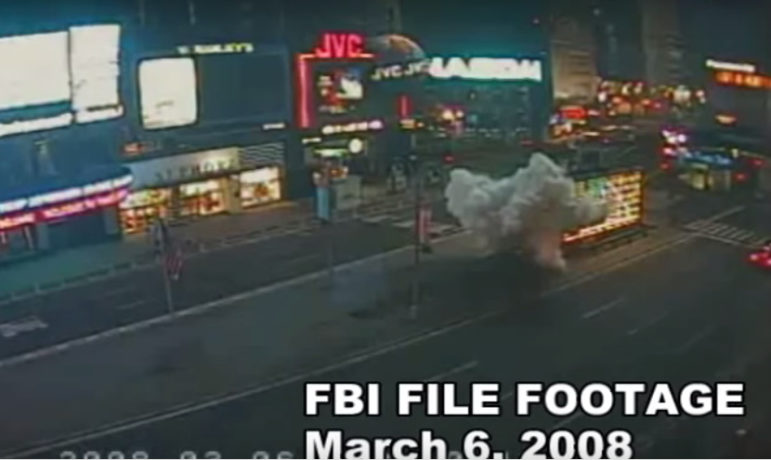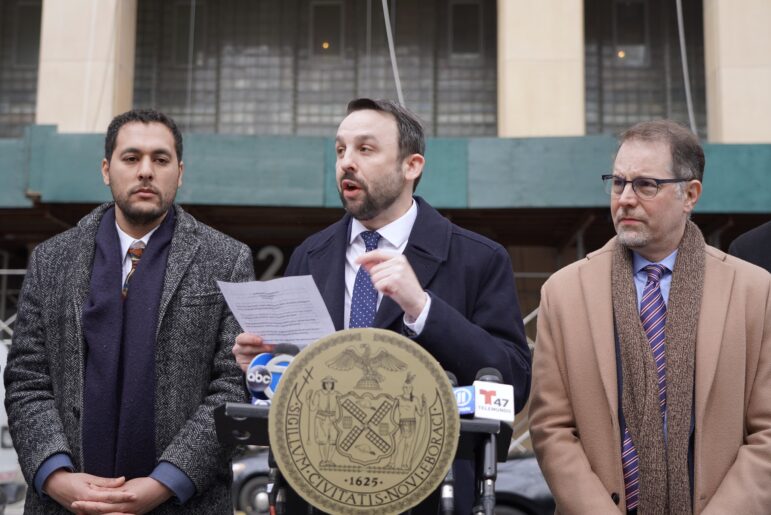
FBI
Surveillance-camera footage of the March 2008 blast outside a Times Square recruiting station, Like several of the bombings in New York’s past century, it remains unsolved.
“Eyewitnesses told different accounts. Some said that the blast gave off a bluish white glare. Others described it as a white ball of fire emitting acrid yellow flames that changed color, spat tongues of green flame, and soared skyward in a pillar of thick brown smoke. Higher and higher soared the smoke, darkening from brown to black and flattening mushroomlike above nearby skyscrapers. Awnings burst into flames a dozen floors above the street. … The blast knocked out windowpanes within a half-mile radius. A man waling along John Street, five blocks north, was felled by a four-inch pipe crashing on the base of his neck.”
-“Wall Street is Bombed,” from The Epic of New York City by Edward Robb Ellis
* * * *
Like the cliché says, change is inescapable in New York City. Neighborhood identities and names shift as buildings give way to newer and higher ones. Fashions and mores evolve and industries rise and fall. Movements and controversies come and go. Yet there has been at least one constant over the past 100 years or so, a period during which the city’s population more than doubled: People using bombs to try to kill other people, as Ahmed Khan Rahami allegedly did over the weekend with two devices left in Chelsea, one of which detonated.
That explosive history isn’t unique to New York, of course; many others cities have a more extensive and bloodier history of bombings. But New Yorkers sometimes recall our sepia-toned history as having been far more orderly and genteel than it actually was. The blasts that have marked each era are a reminder that when the struggles of the day have played out on our streets, they haven’t always restricted themselves to passionate oratory.
A quick look at some of the more notable bombings in the five boroughs establishes another fact that might prove valuable as we analyze the weekend’s events: On more than one occasion, it has remained a mystery exactly who was behind a bomb, or even what was the true motivation for setting a timer or lighting a fuse:
The spring of 1919 saw a rash of mail bombings, some successful and others thwarted, whose targets included New Yorkers J.P. Morgan and John D. Rockefeller and which were blamed on anarchists and other radicals. On June 2, a guard and a passerby were killed when a bomb exploded at the East 61st Street home of Judge Charles Nott. “The explosion was unbelievably powerful,” the Daily News wrote in a 2011 retrospective on the blasts. “Even veterans of World War I in the nearby soldier’s club said it was the loudest blast they had ever heard.” That same day in Washington, an anarchist named Carlo Valdinoci bombed the house of Attorney General A. Mitchell Palmer—an act that killed no one but Valdinoci and led to the infamous Palmer Raids on radicals. No one was ever arrested for the bombing of the Nott home.
The blast described by Ellis in the excerpt above killed 38 people, injured hundreds of others and shook hundreds more. There was never a claim of responsibility for the 100 pounds of dynamite left to detonate at the corner of Wall and Broad streets, but the following day investigators discovered flyers that had apparently been distributed in the area just before the blast that read: “Remember, we will not tolerate any longer. Free the political prisoners, or it will be sure death for all of you. American Anarchist Fighters.” The FBI last looked at the case in 1944, but there was never an arrest.
The NYPD’s bomb squad was in its infancy when detectives Joe Lynch and Freddy Socha carried a bomb found at the British Pavilion of the 1939-40 World’s Fair to remote area. The story goes that Lynch used a knife to cut a hole in the satchel that held the device and said to his partner, “It’s the business,” before the bomb blew up in their faces and killed them both. Three other officers were also injured.
As NYPD historian Bernard Whalen has written, cops questioned members of the Communist Party, Irish Republican Army and Christian Front but focused most of their attention on the German American Bund, a pro-Nazi organization (Britain and Germany had been at war for nine months at the time). No one was ever charged with the bombing, however, and an alternative theory is that it was a false flag operation by the Brits aimed at nudging the U.S. out of its isolationist aversion to fighting Hitler. Whoever the culprit, the bombing was hardly an isolated incident. James Munro, author of a book about that World’s Fair called “Twilight at the World of Tomorrow,” writes:
On June 20, years 1940, a pair of time bombs ripped open office buildings on Battery Place and East 12th Street. Bomb threats reached a peak of nearly 400 every week. We like to think of those days as innocent, softened by the selective memory of nostalgia, but prewar New York City was perhaps as dangerous then as it is today when it comes to acts of terrorism.
The explosion in a locker at a 14th Street subway station hurt no one, but a few weeks later a local paper received this note:
HAVE YOU NOTICED THE BOMBS IN YOUR CITY – IF YOU ARE WORRIED, I AM SORRY – AND ALSO IF ANYONE IS INJURED. BUT IT CANNOT BE HELPED – FOR JUSTICE WILL BE SERVED. I AM NOT WELL, AND FOR THIS I WILL MAKE THE CON EDISON SORRY – YES, THEY WILL REGRET THEIR DASTARDLY DEEDS – I WILL BRING THEM BEFORE THE BAR OF JUSTICE – PUBLIC OPINION WILL CONDEMN THEM – FOR BEWARE, I WILL PLACE MORE UNITS UNDER THEATER SEATS IN THE NEAR FUTURE. F.P.
Indeed, there had been several unexplained bombings in and near the city over the previous several months: two at Grand Central Station, one at the New York Public Library, and one at the ConEd building in White Plains. It turns our these were all the work of the “Mad Bomber,” George Peter Metesky, who over a period of 16 years planted 33 bombs, 22 of which exploded hurting 15 people but killing no one. He was arrested in 1957 after an investigation noted for its innovative use of psychological profiling. It emerged that Metesky was upset with ConEd over a workplace accident and bombed other sites after his attacks on ConEd garnered what he deemed insufficient attention in the press.
“In the 1960s, a different kind of urban terrorism afflicted New York, as the city became a battleground for various groups advocating racial justice, national independence, ethnic pride, and revolution,” wrote Jeffrey A. Kroessler of the John Jay College of Criminal Justice in an excellent 2014 paper on local terrorist violence from 1960 to 1980. “For more than two decades, the city endured jetliner hijackings, bank robberies, attacks on police and other arms of government, and many, many bombings, several resulting in death and serious injury. The groups responsible for these terrorist actions included anti-Castro Cubans, the Jewish Defense League, the Black Panthers and the Black Liberation Army, FALN (Fuerzas Armadas de Liberacion National), Fighters for Free Croatia, the Weather Underground, and the United Freedom Front, as well as black, white, and Puerto Rican radicals acting on their own.”
One of those groups was Cuban Power, an anti-Castro terrorist group that attacked the Cuban government and entities in other countries that it deemed sympathetic to the communist regime. The blast at the Mexican consulate on the 18th was followed four days later by another at the Spanish National Tourist Office in New York . In later months, the group bombed Channel 13, the Bank of Tokyo Trust Company, the Cuban and Yugoslav missions to the United Nations and the Australian, Canadian, French, Japanese and Mexican tourist offices; the Spanish tourist officials was bombed a second time.
The bomb that killed four people when it blew apart the famed tavern—where General George Washington delivered his famous farewell to the officers with whom he’d served—was claimed by the Armed Forces of Puerto Rican National Liberation, or FALN. It was part of a larger campaign of violence by the FALN, but no one was ever charged with the attack on the lower Manhattan bar.
Just after noon on a Friday, a 1,500-pound bomb detonated in a parking garage under the World Trade Center. It killed six and injured 1,000. It also “exposed vulnerabilities in the World Trade Center’s and the city’s emergency preparedness,” according to the September 11 Commission—although not all the lessons learned in 1993 led to corrective action in time for the far more destructive attack on the site eight years later. Investigators found a vehicle identification number among the wreckage and matched it to a rental van, then managed to capture one of the bombing team as he tried to recoup his $400 deposit on the vehicle. Three more arrests followed, and investigators learned of a larger plot to bomb tunnels, the United Nations and 26 Federal Plaza. In June, an FBI raid in Queens “caught several members of a terrorist cell in the act of assembling bombs,” according to the bureau’s own history of the episode.
The leader behind the attacks, Ramzi Yousef, was captured in Pakistan two years later and sent to the U.S. One of the alleged plotters, Abdul Yasin, remains on the FBI’s most wanted list.
The bomb that exploded in the early afternoon on a No. 4 train was made of “mayonnaise jars, kitchen timers, batteries and flashbulb,” according to The New York Times, but it was violently effective, injuring 48 people, 14 of them seriously. It was actually the second bomb deployed by Edward J. Leary, a computer analyst who was upset about losing his job: His first attack, on a No. 3 train, hurt two teenagers and the cops thought one of them had carried the device. But Leary was hurt in the second bombing, and aroused suspicion when he departed the scene in a different train instead of waiting for treatment. He was sentenced to up to 94 years in prison and is incarcerated at Sing Sing. When he was convicted, his wife told reporters: “I think my husband was nuts.”
The bomb left next to the Armed Forces Recruiting Station early on a Thursday morning injured no one but, the FBI points out, “the device could have caused significant casualties if people had been close to the blast”—and security-camera footage of the scene shows several people walking right past the site of the blast in the minutes before it went off. “Several people of interest have been identified and are actively being pursued,” according to the bureau, but in order to move the case along the reward for information was upped to $100,000 last year. The Times Square blast, which involved an ammunition can “commonly found on the battlefields of Afghanistan and Iraq,” was similar to other unsolved explosions at the British Consulate in 2005 and the Mexican Consulate in 2007.
“The case remains a top priority of the FBI’s Joint Terrorism Task Force due to the seriousness of the crime,” reads the 2015 bulletin on the incident. “There is no statute of limitations.”









2 thoughts on “UrbaNerd: Bombs and the City”
Weak job of trying to minimize the islamist-inspired bombings in Chelsea and in NJ. Keep telling yourself that everything is o.k.
You’re right Native New Yorker! Only bombings by people you find undesirable are scary and bad!